History of Ivangorod Fortress
In 1492 the fortress was erected on the Devichja (Maiden) Mount just in front of Livonian fortress of Narva. It was built under order of czar Ivan III and was named after him - Ivangorod. The little square installation with four towers was built in two months. In 1495 the road to the Russian fortress Jam was built.
August 1496 Swedish descent of 70 ships appeared in the Narva river estuary and after fierce storm the fortress fell. Swedes tried to sell the fortress to Livonian order, but unsuccessfully.
In that year the Russian troops got from the Jam city and reconstruction of Ivangorod fortress began. Bolshoi Boyarskij Gorod (Big Boars Town) was built on the eastern side of original installation. All work's length was only three months. The constrictions managers were Ivan Gundor and Mikhail Kljapin. New fortress has walls of 19 meters height and towers of 20-22 meters height. The installation's square was expanded in 8 times. The Livonia got the new problem -"eine Trutz Narva". The age-old rivalry of two fortresses began.
In 1498 the Nikolskaja (st. Nikolas) church was erected in the fortress. In 1507 construction of Zamok (Castle) fortifications around of old installations of 1492 began under control of work masters Vladimir Torokan and Marc Greck.
In 1558 the Livonian War was begun by czar Ivan IV. April 1558 the 9-days bombardment of Narva from Ivangorod fortress was held. Narva answered also. May, 11 the big fire in the Narva city occurred by unknown till nowadays reasons. The Russian took the advantage, crossed the river and seized Narva city and fortress. In that year, the bridge between two fortresses was built.
In the course of the war, the Livonian Order was demolished, but the new pretenders to Livonian lands appeared. Poles and Swedes joined the war. In 1579 admiral Bengt Svirson with Swedes cohort got to Narva estuary and begun to desolate the vicinities of Narva and Ivangorod. The unsuccessful storm of Narva fortress was in September of that year. September 6, 1581, Pontus De-la-Gardi with big Sweden body of troops seized the Narva by decisive assault. In 1583 Swedes sealed the capture of Narva and Ivangorod fortress by Pljussa peace treaty.
In 1590 Russians troops under command of czar Feodor Ioannovitch in person besieged fortress of Narva without success. Under armistice condition, fortress of Ivangorod and fortresses Jam and Koporje with all its warehouses and artillery shells were yielded to Russia.
In the Time of Troubles (Smutnoe Vremja - 1612) the Ivangorod fortress was in the hands of self-styled czar Ldjedimitrij II, and then short time deacon Sidorka (or Ldjedimitrij III) was master in the fortress. December 3, 1612, the fortress was seized by Swedes after one half year siege. In 1617 the Stolbovskij peace treatment was signed and Ivangorod and all other fortress of Izjora land (Ingermanland) were given to Swedes "forever".
August 1700 the Great Northern war began with an unsuccessful siege of Narva fortress by Russian troops. Russians were smashed by Swedish king Karl XII, but there was another siege in 1704. August, 9, Narva fortress fell after 9-days bombardment and fierce assault under the command of czar Peter I in person. August 16, Swedes garrison yielded the fortress of Ivangorod up with all its artillery (4 guns) and was let off with personal ammo and arms. The Northern war was finished in 1721 with the signing of the peace treaty in Nishtadt. The Ivangorod and Narva become the Russian fortresses.
In 1728 review of Ingermanland's fortresses was held by a Military Board (Voennaja Collegia) of Russian Empire. It was concluded that the installations were in neglect condition and had a low fighting efficiency. The special order was issued about fortress of Ivangorod about its preservation and restoration of its old installations. However, in 1738 after inspection the fortress was found non-adequate for defense purpose.
In 1840 some repair and improvements were made in the fortress, namely the tiled roofs were changed to iron sheet roofs and Gronverk was repaired. In 1863 Gronverk was reconstructed, Otvodnaja tower was rebuilt, restored battlement of the walls and towers and stone coverings of the passages to the water (tajnik). In 1911-14, some towers and walls were plastered and whitewashed.
February 24, 1918, the city and fortress of Ivangorod was seized by Germans. September 2, 1920, Ivangorod became a part of newborn Estonian state and changed his name to Janalinn. In 1940 the fortress was named Ivangorod again and together with Estonian state and other Baltic States became a part of happy family of Socialists Republics of Soviet Union.
August 15, 1941, Germans seized Ivangorod again. There were two POW concentration camps in the fortress. The fortress was cleared from occupants July 25, 1944, but before retreat the Germans blown up 6 corner towers, tajniks, walls and all inside buildings of the fortress.
October 1944 warrant officer of 3-d tanks corps Langevitch and rotenfurer SS Venrich were taken captive. Their evidence: "... winter of 1943 the commander of 32-nd engineer regiment obershturbanfurer SS Shoinman ordered to blow up the fortress. As the person in charge was appointed obershturbanfurer Shoffer." The firing continued 7 days. There were need more than 3 tons of explosives for demolishing each tower.
November 1944 the Ivangorod city was included in body of Leningrad area. It got a city status in 1954 (it was an urban settlement before that). In 1991 Estonia state revived, and state border returned to its old place of 1492 at Narva river. The Ivangorod became the border fortress again.
Impressions
Very fine impressions. The weather was fine too, I think because of global thaw. The fortress is very picturesque and considerably clean. The unrestored parts of the fortress are very interesting. There are some vaults in the fortress, so lantern will not extra thing. You can walk near to everywhere in the fortress, except upper levels of towers and fighting gallery of western wall of Big Boyars Town.
Very impressive sights of confronting fortress of Narva across the river. The cheerful tourist's crowds in the Narva fortress yard are just on good musket shoot distance from the towers of Zamok (it is a joke, of course).
Land forts and fortress:
Bip Castle Gatchina Ivangorod Izborsk Kexholm Kirillov Monastery Koporye Novgorod Pechorskiy Monastery Peter&Paul Fortress Porkhov Pskov Schlisselburg Staraya Ladoga Tikhvin Vyborg Hameenlinna Hamina Kastelholm Kymenlinna Lappaenranta Raseborg Castle Savonlinna Tavetti Turku Visby Fredrikstadt Fredriksten Hegra Fort Hoytorp Fort Arensburg Narva Tallinn Antipatris Caesarea Jerusalem Latrun Fort Masada
Sea forts and fortresses:
Alexander Fort Ino Fort Krasnaya Gorka Fort Kronstadt: Kotlin isl. Kronstadt: North Forts Kronstadt: South Forts Trongsund Hanko Svartholm Sveaborg Marstrand Siaro Fort Vaxholm Oscarsborg
Artillery batteries and individual guns:
Coastal Artillery Hemso Fort
Fortified areas and defensive lines:
Karelian Fortified Area (KaUR) KrUR Leningrad Mannerheim Line Nevsky Bridgehead VT Line Harparskog Line Salpa Line Gothland
Russian
S e a r c h All news

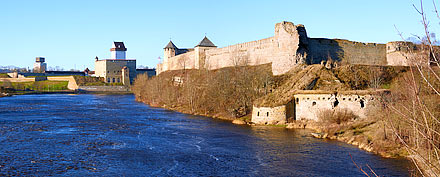 Two towers - Ivangorod & Narva fortress.
Two towers - Ivangorod & Narva fortress.
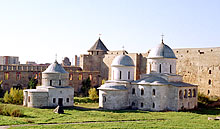 The courtyard of the Big Boyar city in Ivangorod
The courtyard of the Big Boyar city in Ivangorod
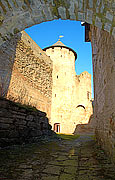 On the walls of the Ivangorod fortress during the next historical festival
On the walls of the Ivangorod fortress during the next historical festival
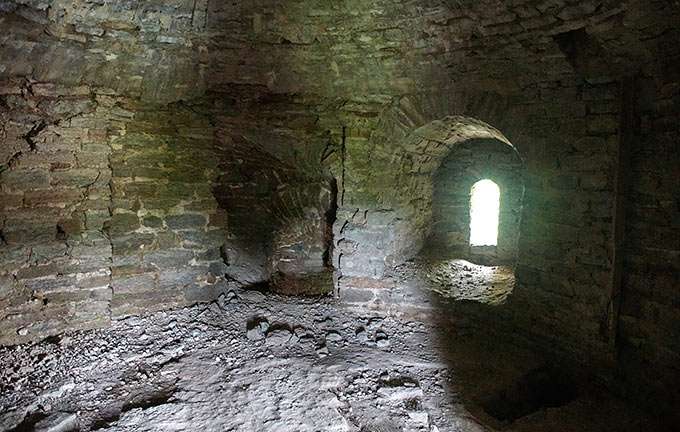 Interiors of the Provision Tower
Interiors of the Provision Tower
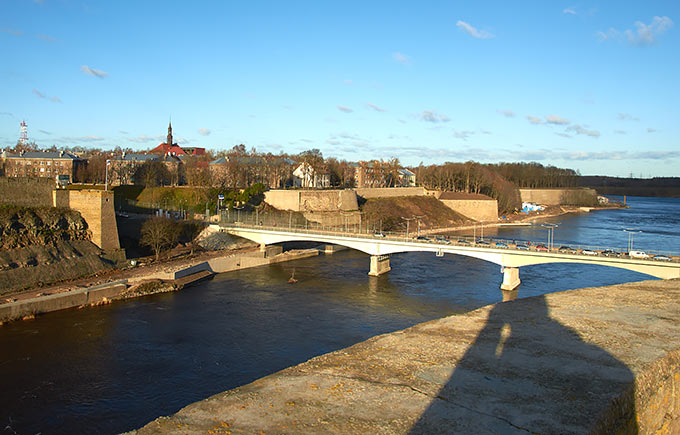 Former Friendship Bridge over the Narova River
Former Friendship Bridge over the Narova River
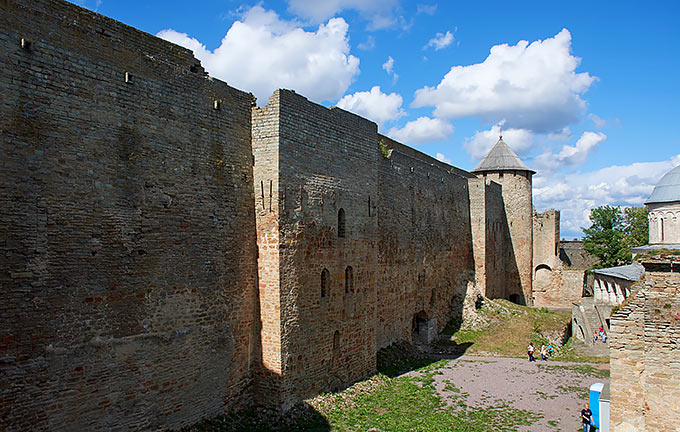 Wall of the Front City in Ivangorod
Wall of the Front City in Ivangorod

